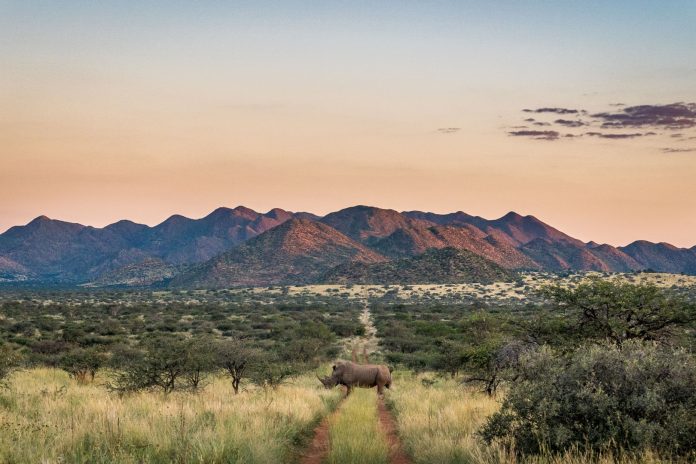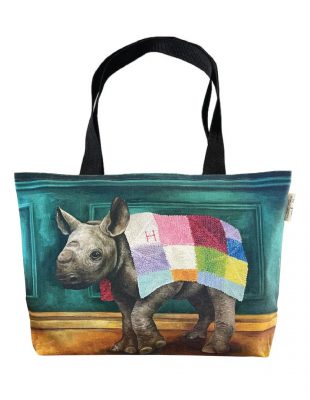If you’re got an adventurous streak and the funds to help, add ‘save the rhino’ to your travel bucket list.
Saving the rhinos … a conservation experience for those committed to help
Tswalu, South Africa’s largest private game reserve, has just introduced an incredible conservation experience for guests who are committed to help save the rhino.
Focusing on generic data collection of endangered rhino populations of the Southern Kalahari ecosystem, you can, until the end of September, join the rhino notching initiative, which analyzes and supports the genetic integrity of the protected rhino populations across South Africa – populations that we all know have, over recent years, suffered a tragic decline.
During this intimate wildlife experience, trained trackers and veterinarians set out across the Kalahari to dart young rhinos – those ideally between two and three years old. After marking and associating the rhino with a recorded number, the team plants a small microchip under the skin and horns for future identity and security purposes. DNA samples are then collected and later added into a global DNA database that helps track and prevent illegally traded rhino horns.

During this encounter, as a guest you’ll form part of the ground crew, and will be invited to take part in this microchipping experience … including helping to monitor the rhinos body temperature and breathing. Tswalu Kalahari, set in the green Kalahari, has a low-impact, high-value approach to ecotourism, and ensures that revenue flows directly back into conservation work.
With only two camps – The Motse and Tarkuni – Tswalu accommodates just 30 people and has the lowest guest footprint in South Africa. The luxurious property has a foundation dedicated to research, and this research affects every conservation decision taken and is a vital part of what Tswalu is all about.
And when you stay at Tswalu, you know you’ll be contributing to the sustainability of their commitment to preserving the southern Kalahari’s biodiversity for future generations.
For this special experience, a stay of a minimum of three or four nights is recommended, and the rhino activities depend on the research cycles of the reserve, so make sure you enquire before booking. It’s a top-end lodge, with rates set accordingly, but they do need to be seen in context of helping to fund the scientific research. The cost of this private rhino notching experience covers the costs of a wildlife veterinarian, the specialized drugs in the darts, and flying expenses. If you’d like to take it even further, you can also donate direct to the reserve, with all funds directly contributing to a credible and imperative rhino conservation project to re-establish populations where they can be protected.
Details: For rates and dates of rhino conservation and research activities, contact Tswalu Reservations on [email protected], or visit tswalu.com
Fighting the rhino war … & building up an exceptional anti-poaching unit
In 2012, retired South African general Johan Jooste was parachuted into the seemingly unwinnable war against rhino poaching in the Kruger National Park. With poaching spiralling out of control, Jooste was given the mandate to ‘go military’, to convert Kruger’s ranger corps into a paramilitary force capable of taking the fight to the poachers. Aged 60, white, and a veteran with 35 years’ military service, Jooste’s controversial appointment was immediately met with resentment and outright hostility by elements of South African National Parks, the police, and even the military with which he had served. With the media, government, conservationists, human-rights activists and the people of South Africa looking over his shoulder, Jooste had to battle opponents within and without to carry out his strategy for turning the tide on rhino poaching. Rhino War by Jooste with Tony Park (bestselling author of thriller novels set in Africa) tells how Jooste, facing an unprecedented assault on a national park and a single species, turned a force of demoralised men and women into arguably the finest anti-poaching unit on the African continent. Told through his eyes, these stories of the courage and grit of rangers who risked their lives to protect wildlife in the face of a wily and determined foe are an account of heroism, sacrifice and determination. Humbly, honestly and decisively, Jooste tells of the successes and failures of his bold strategy, and shares his vision for the future. Macmillan, R340
Wild options for young travellers …
This Wild Warrior Kids’ Rhino Canvas Bag is perfect for children to keep their goodies while on safari. It’s got a waterproof lining, a magnetic clip closure and – most importantly – is made locally by Whimsical Collection, who make donations to The Rhino Orphanage in Limpopo Province, which rears babies that have lost their mothers to poaching. R495 from whimsicalcollection.co.za

What colour is a black rhino? And how did the white rhino get it’s name? How does a gemsbok stay cool in the desert? Why should you never pick up a bullfrog? Which predators have the cleverest hunting techniques? The World of African Wildlife by Owen Hendry is a safari guide for young explorers. Besides being jam-packed with fascinating facts and photographs of wild animals, birds and insects, it also has loads of additional activities like puzzles and word games. With a fun layout and plenty of images, it’s the perfect book to keep young wildlife fans busy for ages, and we’d definitely recommend you pack up a copy if you’re off for a safari with the kids anytime soon. Struik Nature, R170








